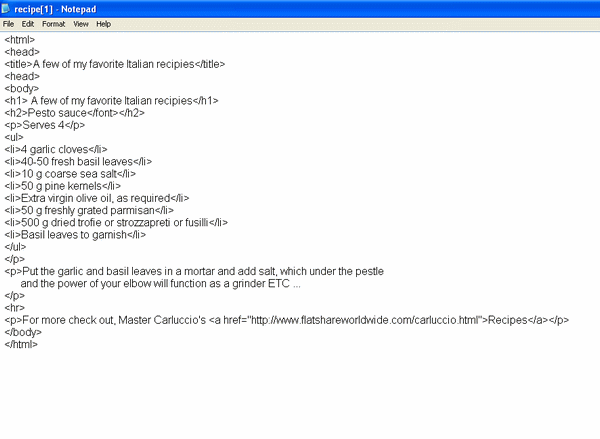Lecture Summary 1
Prepared by: Anthony Larrain
What You Need
- An editor
- Access to Webserver. See lab 1 about 000webhost
Classroom Conduct
Attendance
Attendance is not required. More than half of the class time will be devoted to working on labs. Lab work accounts for 40% of your grade. If you miss a class you will have to do the labs on your own and turn them in by the due date.
Talking
During the lab it is okay to quitely talk with your classmates. During lecture no talking allowed.
Eating and Drinking
This class meets in a lab. The lab policy is no eating and drinking. I will allow drinking but no eating. If you have to eat you can do so during the lab portion of the class. Just leave the room.
Breaks
There will be no scheduled break. If you have to leave for a moment feel free to do so. Probably best to wait until the lab.
Internet Basics
- A network consists of two or more computers interconnected so that they can communicate and share information or resources.
- The Internet is a world wide collection of computer networks - a network of networks. The Internet is not a place. You do not download a file from the Internet you download the file from some computer.
- A Web server is a special computer on the Internet running special software. The function of a web server is to send certain types of files to computers that request those files.
- A program, called a browser is used to request, read and display these files.
- Common Browsers:
- Internet Explorer
- Netscape Navigator
- Mozilla Firefox
- Opera
- Safari (Mac)
- The World Wide Web is the part of the Internet consisting of web servers and the files they deliver.
- Some types of files a web server can deliver are: web pages, image files, movie files, audio files.
- To request a web page, you need to know:
- The name of the server.
- The name of the file.
- Where to find the file on the server.
- A URL or Uniform Resource Locator is like the address of the web page. It consists of three main parts:
- Protocol. The
http://part, which stands for Hypertext Transfer Protocol. - The name of the server computer
members.aol.com - Pathname
/donnaskani/filetypes.html. The pathname tells the server which file and where to find that file on the server.
- Protocol. The
- The
WorldWideWeb, WWW, is based on the client/server model. When you request a page, your browser becomes a client of the web server. The web server sends a copy of the file to your computer. - What is in this file ?
- To see the contents of this description file or codes, in windows, right click on the web page, and select
View SourceOR
From the menu bar at the top of your browser select
view, then selectsource. (If you are using a mac and the safari browser this also applies)Example
Type the following URL into your browser.
http://condor.depaul.edu/~alarrain/hci201/examples/recipe.html Next view the source following the above procedure. You should see something similar to this.

These special codes are written in the
HyperTextMarkupLanguage, HTML. We will refer to these codes as the HTML. The above file is called anhtml file - Web pages will often contain links, called hyperlinks that allow you to jump from page to page around the Internet.
- A protocol is a set of rules that regulates the communications between computers on a network.
- There are many parts to the Internet
- The World Wide Web
- The complete set of documents residing on all Internet servers that use the HTTP protocol, accessible to users via a simple point-and-click system.
- File Transfer Protocol
- The protocol for exchanging files over the Internet.
- Telnet
- The protocol that allows you to log on to a remote computer and execute commands as if you were at the remote computer.
Example
To request a web file named filetypes.html on the web server members.aol.com located
in a folder(directory) called donnaskani
you would type the following into the address bar of your browser.
This is referred to as a URL.
The server does not store an image of what the web page looks like but instead, the file contains a description in the form of special codes on how the page should appear. When the browser receives this file it interprets the codes and creates the web page image that we see.